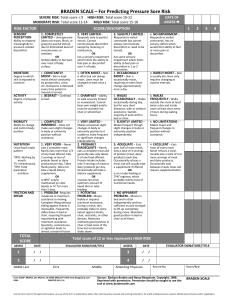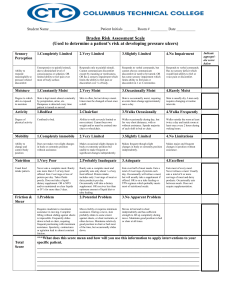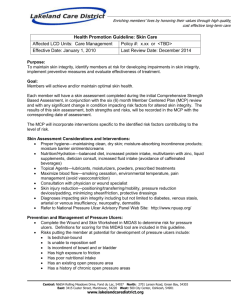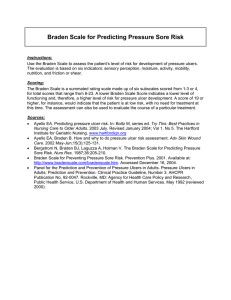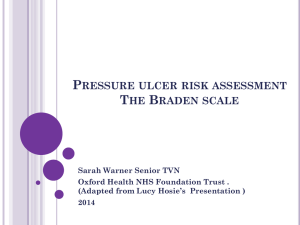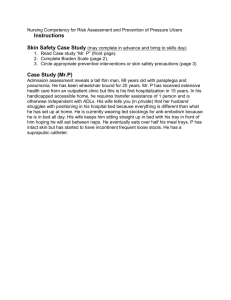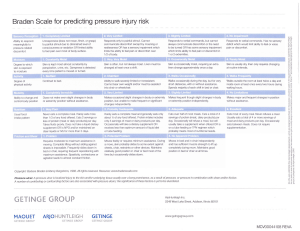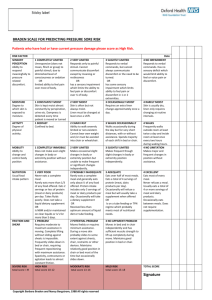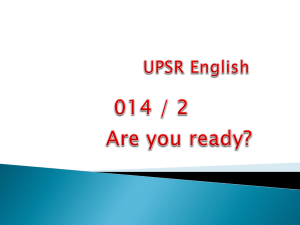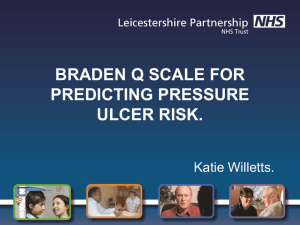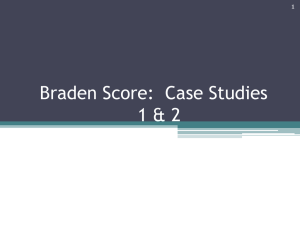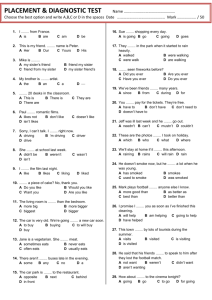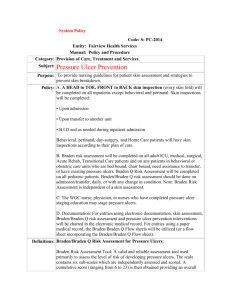Baylor BradenQ Pressure Ulcer Risk Assessment
advertisement
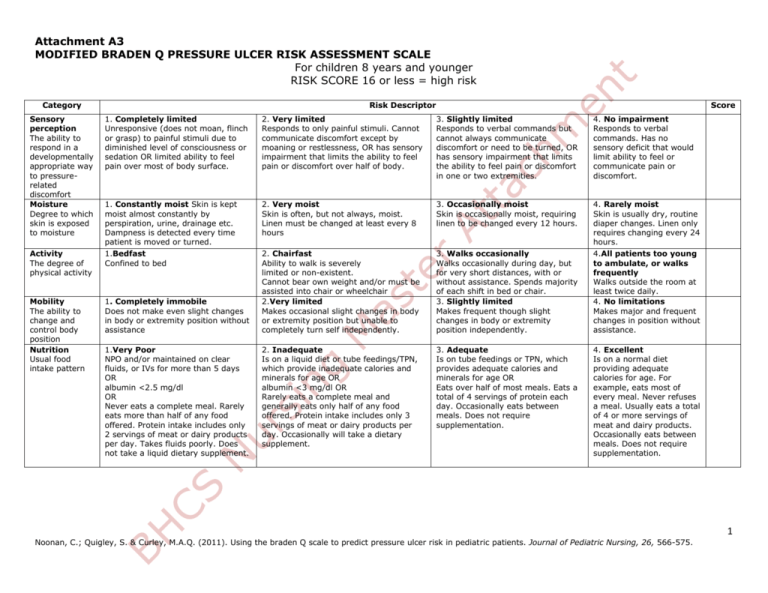
Attachment A3 MODIFIED BRADEN Q PRESSURE ULCER RISK ASSESSMENT SCALE For children 8 years and younger RISK SCORE 16 or less = high risk Category Sensory perception The ability to respond in a developmentally appropriate way to pressurerelated discomfort Moisture Degree to which skin is exposed to moisture Activity The degree of physical activity Mobility The ability to change and control body position Nutrition Usual food intake pattern Risk Descriptor Score 1. Completely limited Unresponsive (does not moan, flinch or grasp) to painful stimuli due to diminished level of consciousness or sedation OR limited ability to feel pain over most of body surface. 2. Very limited Responds to only painful stimuli. Cannot communicate discomfort except by moaning or restlessness, OR has sensory impairment that limits the ability to feel pain or discomfort over half of body. 3. Slightly limited Responds to verbal commands but cannot always communicate discomfort or need to be turned, OR has sensory impairment that limits the ability to feel pain or discomfort in one or two extremities. 4. No impairment Responds to verbal commands. Has no sensory deficit that would limit ability to feel or communicate pain or discomfort. 1. Constantly moist Skin is kept moist almost constantly by perspiration, urine, drainage etc. Dampness is detected every time patient is moved or turned. 1.Bedfast Confined to bed 2. Very moist Skin is often, but not always, moist. Linen must be changed at least every 8 hours 3. Occasionally moist Skin is occasionally moist, requiring linen to be changed every 12 hours. 2. Chairfast Ability to walk is severely limited or non-existent. Cannot bear own weight and/or must be assisted into chair or wheelchair 2.Very limited Makes occasional slight changes in body or extremity position but unable to completely turn self independently. 3. Walks occasionally Walks occasionally during day, but for very short distances, with or without assistance. Spends majority of each shift in bed or chair. 3. Slightly limited Makes frequent though slight changes in body or extremity position independently. 4. Rarely moist Skin is usually dry, routine diaper changes. Linen only requires changing every 24 hours. 4.All patients too young to ambulate, or walks frequently Walks outside the room at least twice daily. 4. No limitations Makes major and frequent changes in position without assistance. 2. Inadequate Is on a liquid diet or tube feedings/TPN, which provide inadequate calories and minerals for age OR albumin <3 mg/dl OR Rarely eats a complete meal and generally eats only half of any food offered. Protein intake includes only 3 servings of meat or dairy products per day. Occasionally will take a dietary supplement. 3. Adequate Is on tube feedings or TPN, which provides adequate calories and minerals for age OR Eats over half of most meals. Eats a total of 4 servings of protein each day. Occasionally eats between meals. Does not require supplementation. 1. Completely immobile Does not make even slight changes in body or extremity position without assistance 1.Very Poor NPO and/or maintained on clear fluids, or IVs for more than 5 days OR albumin <2.5 mg/dl OR Never eats a complete meal. Rarely eats more than half of any food offered. Protein intake includes only 2 servings of meat or dairy products per day. Takes fluids poorly. Does not take a liquid dietary supplement. 4. Excellent Is on a normal diet providing adequate calories for age. For example, eats most of every meal. Never refuses a meal. Usually eats a total of 4 or more servings of meat and dairy products. Occasionally eats between meals. Does not require supplementation. 1 Noonan, C.; Quigley, S. & Curley, M.A.Q. (2011). Using the braden Q scale to predict pressure ulcer risk in pediatric patients. Journal of Pediatric Nursing, 26, 566-575. Attachment A3 MODIFIED BRADEN Q PRESSURE ULCER RISK ASSESSMENT SCALE For children 8 years and younger RISK SCORE 16 or less = high risk Friction Shear Friction occurs when skin moves against support surfaces. Shear occurs when skin and adjacent bony surface slide across one another Tissue perfusion and oxygenation 1.Significant problem Spasticity, contractures, itching or agitation leads to almost constant thrashing and friction. 2. Problem Requires moderate to maximum assistance in moving. Complete lifting without sliding against sheets is impossible. Frequently slides down in bed or chair, requiring frequent repositioning with maximum assistance. 3. Potential problem Moves freely or requires minimum assistance. During a move, skin probably slides to some extent against sheets, chair, restraint or other devices. Maintains relative good position in chair or bed most of the time but occasionally slides down. 4. No apparent problem Able to completely lift patient during a position change, moves in bed and in chair independently and has sufficient muscle strength to lift completely during move. Maintains good position in bed or chair at all times. 1.Extremely compromised Hypotensive; (MAP<50mmHg;<40 in newborn) OR the patient does not physiologically tolerate position changes. 2.Compromised Normotensive; oxygen saturation may be <95%; OR hemoglobin may be <10mg/dl; OR capillary refill may be >2 seconds; serum pH is <7.40. 3. Adequate Normotensive; oxygen saturation may be <95%; OR hemoglobin may be <10mg/dl; OR capillary refill may be 2 seconds; serum pH is normal. 4. Excellent Normotensive, oxygen saturation >95%, normal hemoglobin, & capillary refill <2 seconds. Score Total Score: 2 Noonan, C.; Quigley, S. & Curley, M.A.Q. (2011). Using the braden Q scale to predict pressure ulcer risk in pediatric patients. Journal of Pediatric Nursing, 26, 566-575.
